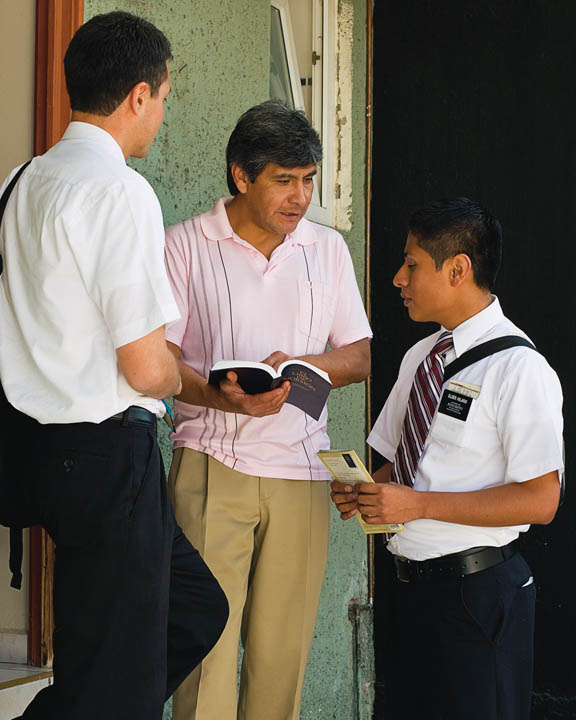 Missionaries are called into one of over 400 missions worldwide. A “mission” is an area of administration with a “mission president” who oversees the missionary work in the area. Some missions are geographically small, and others are very large, depending on the Mormon presence in the area and local interest. For instance, the city of Santiago, Chile, is divided into four separate missions, and each has its own mission presidency. There is much interest in the Church in Chile and a large population in Santiago. However, a mission in Russia might encompass hundreds of square miles.
Missionaries are called into one of over 400 missions worldwide. A “mission” is an area of administration with a “mission president” who oversees the missionary work in the area. Some missions are geographically small, and others are very large, depending on the Mormon presence in the area and local interest. For instance, the city of Santiago, Chile, is divided into four separate missions, and each has its own mission presidency. There is much interest in the Church in Chile and a large population in Santiago. However, a mission in Russia might encompass hundreds of square miles.
A potential missionary receives a call to serve after he has stated a desire and made any necessary life adjustments with the help of the bishop of the “ward” (parish) in which he resides. The “call” arrives as a letter from the First Presidency of the Church. The potential missionary can request a locality where he desires to serve, but all mission calls are the result of prayer and inspiration, so his request might be ignored if inspiration dictates that there is a better place for him.
Missionary service begins at an “MTC” or missionary training center. There are missionary training centers in Provo, Utah; Preston, England; Buenos Aires, Argentina; Sao Paulo, Brazil; Mexico City, Mexico; Santiago, Chile; Bogotá, Colombia; Lima, Peru; Guatemala City, Guatemala; Hamilton, New Zealand; Tokyo, Japan; Seoul, South Korea; Santo Domingo, Dominican Republic; Madrid, Spain; Accra, Ghana; Johannesburg, South Africa; and Manila, Philippines. A missionary destined to serve in an area where he will be speaking in his native tongue will spend only a brief time in an MTC. There, he will learn more about the gospel, and will prepare to teach and to serve. Those missionaries who need to learn a foreign language in order to serve receive intensive language instruction at the MTC and are there longer.
After preparation and instruction at an MTC, each missionary is sent to the mission where he will serve. Once in the mission field, the missionary is assigned a “companion.” Companionships are an important aspect of missionary service. Missionaries serve “two-by-two” for their own safety and spiritual well-being. Usually, one member of a companionship will be more experienced and can help a “green” missionary learn the ropes. Companionships are temporary. Often, missionaries are transferred to other locales within the mission. This provides new experiences for the missionaries and keeps people who are new to the gospel from relying too much on one person for their connection to the Church. Missionaries learn much from their companions; often, patience is the most important personality characteristic fine-tuned in a companionship.
The main purpose of most Mormon missionaries’ service is to share the gospel with those who are searching for meaning in their lives. Missionaries are instructed to teach everywhere, and to everyone who desires to hear the message, although missionaries don’t venture beyond the boundaries of the missions to which they are assigned. Missionaries are well-known for their door-to-door approach of sharing the gospel, but proselyting missionaries use every opportunity to teach, whether it be on the subway or in the supermarket. Other missionaries are there specifically to serve the community and do no proselyting. Mormon missionaries also serve fellow Mormons in their congregations. Missionaries often teach lessons in church services. They also participate in local service projects, community service, and help those with special needs. Members of the Mormon Church are expected to support the missionaries in their area. In most wards, members invite missionaries over to dine with their families.
 Missionaries live a disciplined life, waking everyday at six or six-thirty and retiring early to bed. Mormon missionaries engage in daily scripture study with their companions. They pray daily to have the Holy Ghost direct them to those who are ready to hear the gospel. Their days are spent going door to door and teaching those who seek to learn more about Mormonism. Most missionaries use bikes as their main mode of transportation. In some areas, missionaries use cars to get from place to place. Male Mormon missionaries are easy to recognize in their dark suits and name tags. Sister missionaries always wear dresses.
Missionaries live a disciplined life, waking everyday at six or six-thirty and retiring early to bed. Mormon missionaries engage in daily scripture study with their companions. They pray daily to have the Holy Ghost direct them to those who are ready to hear the gospel. Their days are spent going door to door and teaching those who seek to learn more about Mormonism. Most missionaries use bikes as their main mode of transportation. In some areas, missionaries use cars to get from place to place. Male Mormon missionaries are easy to recognize in their dark suits and name tags. Sister missionaries always wear dresses.
While on a mission, Mormon missionaries literally leave the world behind to focus on the Lord’s work. They don’t speak with their family or friends from home, except through letters, or infrequent emails, or two phone calls home each year. They don’t listen to radio or worldly music. They live humbly, with few material possessions. This may seem like a lot to ask of young men and young women, but by leaving the things of this world behind, missionaries can be more focused on proselyting and becoming more spiritually connected to the Lord.
Missionary experience changes young men and women for the better. By serving a mission, young people learn to be kind, service-oriented, and Christ-like. Missionaries strive to enrich the lives of those around them, and in so-doing, develop a deep love for the people and countries where they serve. They develop the ability to fellowship other people with sincere warmth, while they develop leadership ability as well as the ability to follow direction that comes from above. These talents, along with fluency in a foreign language and culture, translate very well to the marketplace upon the missionary’s return home. Former missionaries are in great demand in the business world, as employers have recognized their desirable qualities.
Spreading the Word: An article about Mormon missionaries in California.
